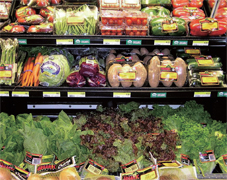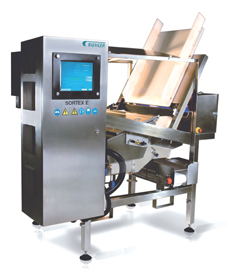Sorting technologies can ensure quality, yield and the highest level of food safety for produce processors
INCREASED consumption of fruits and vegetables plays an important role in human health, as the importance and influence of the diet on health is undisputed. Dietary guidelines from government agencies and recognized health professional organizations across Asia recommend five or more servings of fruit and vegetables along with daily decreased consumption of fats and cholesterol, increased intake of grain products, and maintenance of desirable body weight. Recognition of the importance of routine fruit and vegetable consumption, together with the marked increase in the year-round availability of fresh produce from a global market, has contributed to the substantial increase in consumption of fresh fruits and vegetables in developed countries in North America and the European Union. These markets are important export destinations for fresh and frozen produce processors in Southeast Asia.  To minimize costly rejection of shipments and loss of supply contracts, growers, packers, and shippers are urged to take a proactive role in minimizing food safety hazards potentially associated with fresh produce. Furthermore, operators should encourage the adoption of safe practices by their partners along the farm-to-table food chain, including transporters of produce, such as distributors, exporters, importers, retailers, food service operators, and consumers, to ensure that each individual effort will be enhanced. The consequences of foreign material contamination, for instance, may be serious for processors. Once consumer confidence is shaken, it is expensive and labor-intensive to restore. Space-age technology for frozen produce For frozen food processors, the packing line is the last opportunity to eliminate foreign matter. Traditional technologies have long been used to remove foreign material that was missed in the primary process. But these technologies do not offer absolute safety. For example, they find it hard to distinguish lightcolored wood from potato or cauliflower, cardboard from carrot, or some clear or colored plastics from vegetable mixes. The list of hazards seems endless: cigarette filters, for example, are exceptionally hard to detect in mushrooms. In an increasingly litigious world, the price of inadequate product screening is heavy. To overcome these problems, processors can look to technology that takes advantage of the fact that vegetation absorbs energy in the short-wave infrared (SWIR) spectral region whereas other material reflects it. This the solution used in the new Sortex E from Buhler (Uzwil, Switzerland) ?the Indium Gallium Arsenide (InGaAs) technology, which was developed originally for the space program to distinguish between cultivated and uncultivated fields. It was quickly adopted for military use as it enables an easy distinction to be made between foliage cover and other material such as camouflage.
To minimize costly rejection of shipments and loss of supply contracts, growers, packers, and shippers are urged to take a proactive role in minimizing food safety hazards potentially associated with fresh produce. Furthermore, operators should encourage the adoption of safe practices by their partners along the farm-to-table food chain, including transporters of produce, such as distributors, exporters, importers, retailers, food service operators, and consumers, to ensure that each individual effort will be enhanced. The consequences of foreign material contamination, for instance, may be serious for processors. Once consumer confidence is shaken, it is expensive and labor-intensive to restore. Space-age technology for frozen produce For frozen food processors, the packing line is the last opportunity to eliminate foreign matter. Traditional technologies have long been used to remove foreign material that was missed in the primary process. But these technologies do not offer absolute safety. For example, they find it hard to distinguish lightcolored wood from potato or cauliflower, cardboard from carrot, or some clear or colored plastics from vegetable mixes. The list of hazards seems endless: cigarette filters, for example, are exceptionally hard to detect in mushrooms. In an increasingly litigious world, the price of inadequate product screening is heavy. To overcome these problems, processors can look to technology that takes advantage of the fact that vegetation absorbs energy in the short-wave infrared (SWIR) spectral region whereas other material reflects it. This the solution used in the new Sortex E from Buhler (Uzwil, Switzerland) ?the Indium Gallium Arsenide (InGaAs) technology, which was developed originally for the space program to distinguish between cultivated and uncultivated fields. It was quickly adopted for military use as it enables an easy distinction to be made between foliage cover and other material such as camouflage.  Seizing on this capability, Buhler Sortex applied InGaAs technology to the cameras and sensors it designs. Sensors in InGaAs cameras can detect energy in the SWIR region while conventional sorters use cameras based on silicon technology that can detect energy only in the visible and near infrared (NIR) ranges. The enhanced InGaAs technology makes use of the fact that at certain wavelengths vegetables reflect very little energy while common packaging materials such as plastic, wood and cardboard reflect it very well. Foreign material is highlighted as clearly as under a spotlight. In designing the sorter, a balance was struck between perfection and the cost of achieving it. Its design is so compact that it fits onto a small surface area with little loss of headroom. ItMiesten keng?t laajasta valikoimasta
Seizing on this capability, Buhler Sortex applied InGaAs technology to the cameras and sensors it designs. Sensors in InGaAs cameras can detect energy in the SWIR region while conventional sorters use cameras based on silicon technology that can detect energy only in the visible and near infrared (NIR) ranges. The enhanced InGaAs technology makes use of the fact that at certain wavelengths vegetables reflect very little energy while common packaging materials such as plastic, wood and cardboard reflect it very well. Foreign material is highlighted as clearly as under a spotlight. In designing the sorter, a balance was struck between perfection and the cost of achieving it. Its design is so compact that it fits onto a small surface area with little loss of headroom. ItMiesten keng?t laajasta valikoimasta
 iConnectHub
iConnectHub
 Login/Register
Login/Register Supplier Login
Supplier Login


























